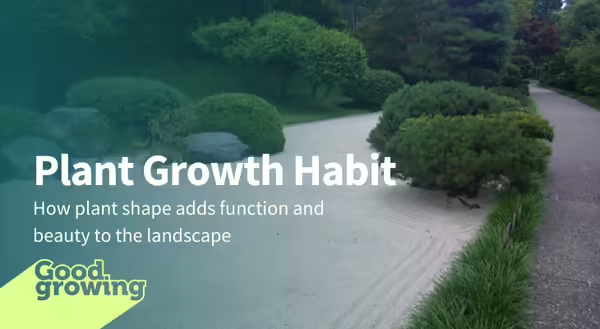
From a horticultural perspective, the term “habit” is not what you think. Though there are certainly some bad habits in gardening like not cleaning soil off tools or buying plants with no feasible location to plant them. When you hear a horticulturist say the term “habit” what we are referring to is the form or shape a plant takes.
For instance, when we describe the growth habit of a tree there are terms you may recognize such as rounded, pyramidal, irregular, and vase-shaped. One growth habit term that I mispronounced most of my career is “fastigiate.” For some reason, my brain wants to say fast-ee-gate, where in reality it is pronounced fas-tij-ee-it. Now that we all know how to say it, what does it mean? Fastigiate is a $20 word for “columnar.”
Habit is primarily determined by genetics. There is more consideration for growth habit than most people realize when it comes to plant breeding. From a green industry perspective yes flowers sell, but a plant that flops over because its flowers are too heavy can lead to a disappointed customer. For example, many hydrangea breeders are pursuing dinnerplate-sized flowers that require an upright growth habit strong enough to support the weight of these massive blooms. At plant breeding presentations, I have seen some absolutely beautiful hydrangea flowers showcasing dazzling colors. However, because the stem can’t support the weight, that unnamed hydrangea ends up in a literal compost heap never to be seen again. What can I say? Plant breeding is cut-throat.
A plant's growth habit certainly has a functional component. Whether you are growing a sturdy hydrangea or a street tree that can create a canopy without getting in the way. A vase-shaped habit for street trees is ideal as they have few lower branches, but higher branches that arch outwards creating a canopy overhead. This is what made the American elm an ideal street tree with its vase-shaped habit. Once we lost our elms, tree growers have worked for decades to fill the void left by Dutch elm disease.
Aside from function, a plant’s growth habit has aesthetic appeal. In the mind of Americans, a street lined with vase-shaped trees is more comforting. One of the best times to observe a plant’s habit is in the winter. I would encourage readers to observe the branching habit of various deciduous trees and shrubs this winter. Some plants provide excellent winter interest based on their habit.
Witch hazel (Hamamelis spp.) comes to mind as a tree that can have various habits depending on what cultivar is selected and where it is planted. Witch hazel is a small understory tree that has a smooth bark that stands out on a snow-covered landscape. Many witch hazels have a vase-shaped habit, yet I recall a witch hazel growing in Southern Illinois that had an incredibly irregular and gnarly form. It looked like some type of haunted tree growing beneath the oaks. This goes to show how the growing location can also play a role in a plant’s habit.
Want to learn more about interesting plant growth habit and other ways we can provide winter interest in the landscape? Register for our upcoming December 15 webinar on Wonderful Winter Interest at go.illinois.edu/GGWinterInterest.
Good Growing Fact of the Week: Our houses are getting bigger, which means yards are getting smaller. Most plant breeders are seeking to produce plants with a dwarf growth habit to fit in our shrinking landscapes.
Signup for our emails! Want to get notified when new Good Growing posts are available? SIGN ME UP
MEET THE AUTHOR
Chris Enroth is a horticulture educator with University of Illinois Extension, serving Henderson, McDonough, Knox, and Warren counties since 2012. Chris provides horticulture programming with an emphasis on the home gardener, landscape maintenance personnel, and commercial landscapers. Additional responsibilities include coordinating local county Master Gardener and Master Naturalist volunteers - providing their training, continuing education, advanced training, seasonal events, and organizing community outreach programs for horticulture and conservation assistance/education. In his spare time, Chris enjoys the outdoors, lounging in the garden among the flowers (weeds to most).